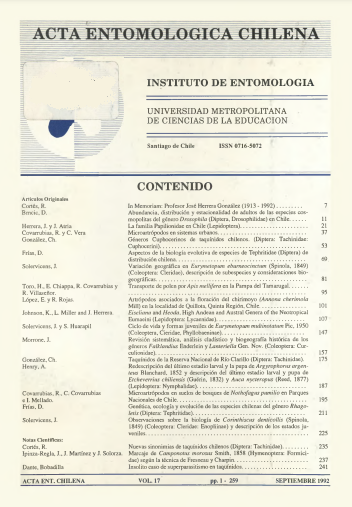Contenido principal del artículo
ago 17, 2022
Resumen
The soil microarthropod fauna was studicd in the urban park Balmaceda, in Santiago, Chile.
A total of 61 samples were taken under five contrasting situations, namely grass (formed by a
complex of species), a shrubby plant Ligusirum sinensis and three species of tree namely,
Cryptocarya alba, Quercus súber and Erythrina umbrosa. Litter or soil samples of 250 mi were
worked out, treated in Berlese-Tullgren funnels.
The average densities for each higher laxa and their standard deviations are given, as well as the
relative abundance and the presence frequencies in the samples. The total amount of recorded
material adds up to 14697 individuáis, distributed in 25 higher laxa of soil microarthropods.
Also presented are the results of the analysis of variance, to test the influence of the factors
"plant growth form” and "tree species" on the abundance of the 7 taxa wilh higher sample
frequencies. The plant growth form factor, showed a significant influence over the abundances of
most of the analyzed taxa and total fauna. The tree species factor showed little influence, being
significant only for Tarsonemid mites and total fauna.
The densities and relative abundance were compared with those of some chilean natural
ecosystems. The absoluto abundance is higher in park than those in meadows and steppes, but lower
to that from forests and tundra. The low proportion of inseets and the high percentage of Tarsonemid
and Acaridida mites was a characteristic in the urban park.
This material in urban parks, easely accesible, is thought to be useful in the achievemenl of
various educational and research objectives, whether be invertebrate zoology or ecology.


